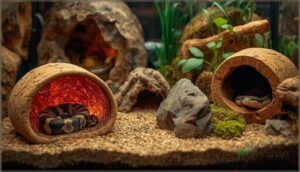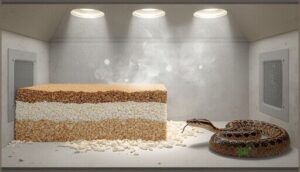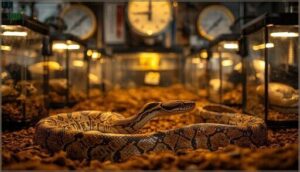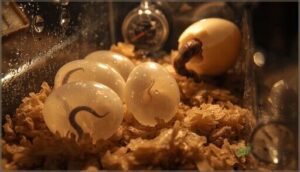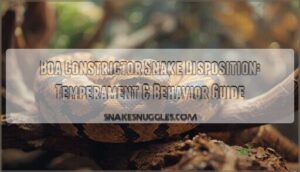This site is supported by our readers. We may earn a commission, at no cost to you, if you purchase through links.

Success hinges on precision: matching species to your skill level, engineering environments that trigger reproductive cycles, and managing everything from pre-breeding conditioning to hatchling care with the rigor of a laboratory protocol.
The gap between amateur attempts and professional results comes down to understanding what actually drives reproductive success in captive serpents.
Table Of Contents
Key Takeaways
- Snake breeding success depends on precise environmental control—temperature errors can kill entire clutches, while maintaining 26–30°C gradients with 40–60% humidity triggers reproductive cycles and prevents the 30% egg loss linked to poor climate management.
- Species selection determines your odds before you start: corn snakes and ball pythons deliver 80–90% breeding success in forgiving conditions, while advanced species like Moluccan scrub pythons show under 5% fertility and demand $5,000+ setups.
- Genetic pairing mistakes produce catastrophic outcomes—spider gene morphs cause neurological wobble in 50% of offspring, lethal combinations yield 25% non-viable hatchlings, and inbreeding increases embryonic mortality by 20–40%.
- Breeding profitability hinges on strategic morph selection and precision protocols: some breeders clear five figures annually from rare genetics, but only through rigorous health screening, accurate sex determination, controlled introductions, and meticulous incubation at species-specific temperatures (ball pythons at 90°F for 55–65 days, corn snakes at 82°F for 58–62 days).
Choosing The Right Snake Species for Breeding
Choosing the right species is the foundation of successful snake breeding, and not all snakes are created equal in terms of captive reproduction. Your decision should balance your experience level, the snake’s temperament, and compatibility factors that directly impact breeding outcomes.
Success in snake breeding hinges on choosing the right species—one whose temperament, environmental needs, and reproductive compatibility align with your expertise and resources
Let’s break down what you need to think about before selecting your breeding stock.
Beginner-Friendly Vs. Advanced Species
When choosing a species, beginners should start with corn snakes or ball pythons—they thrive in forgiving 26–30 °C environments, deliver 80–90% breeding success, and dominate market trends. Beginner-friendly snake species protect genetic diversity and reduce financial risk, while snake morphs in ball pythons can yield 200% annual returns if you avoid inbreeding pitfalls.
Expert species like Moluccan scrub pythons demand precision setups costing over $5,000 and show under 5% fertility.
It’s essential to research and understand the breeding process guidelines before starting a breeding program.
Selecting Docile and Healthy Snakes
You’ll want docile species like ball pythons or corn snakes—veterinarians rank them top for beginners based on behavioral stability. Captive-bred blood pythons now show 80% docility rates thanks to selective breeding.
Consistent handling (5–10 minutes daily) cuts stress responses by 35–45%, while regular feeding patterns and clean shed cycles boost fertility by 20%. Screen for calm temperament using feeding response and body language—snakes scoring 4+ on behavior scales make ideal breeding candidates.
Prioritize snake welfare through 30-day quarantine and health screening before pairing. Understanding proper snake care tips is essential for successful breeding.
Risks of Breeding Venomous Species
Venomous snake breeding demands expertise most private breeders lack. Consider these sobering realities:
- Public Health Risks: The U.S. averages 37 exotic venomous snakebite cases yearly, with delayed antivenom access beyond six hours drastically increasing fatality risk.
- Venomous Bites: Over 60% of private-breeder incidents occur during feeding or transfers—even trained handlers face exposure that can cause amputations within 48 hours.
- Snake Escapes: Released cobras and other escapees disrupt ecosystems and force wildlife agencies to euthanize recovered animals.
- Medical Costs: Global snakebite treatment exceeds $2 billion annually, with victims losing 70 days of productivity per incident.
Risks associated with venomous snakes—legal penalties, ecological damage, and inadequate antivenom access—make venomous snake breeding unsuitable without institutional-level bite prevention protocols and biosafety infrastructure.
Determining Snake Gender and Compatibility
Before introducing breeding pairs, you’ll need accurate sex determination and compatibility assessment. Probing—where a smooth metallic probe inserted into the cloaca penetrates six scale widths in males versus two to three in females—achieves up to 100% accuracy in species like reticulated pythons. Genetic testing using shed skin confirms gender identification non-invasively.
Beyond gender, evaluate breeding compatibility through snake behavior: males reaching 56% of adult length and females at 86% show better mating process success, while observing courtship behaviors like tail alignment helps confirm readiness in your breeding pairs.
Creating The Ideal Breeding Environment
Getting your breeding setup right isn’t just about throwing together a tank and hoping for the best—it’s the foundation of successful reproduction. Your snakes won’t even think about breeding if their environment doesn’t trigger the right biological cues.
Here’s what you need to nail down before introducing your breeding pair.
Enclosure Size and Design Requirements
Your breeding enclosures function like a precision instrument—they must accommodate full adult stretching without restriction. For corn snakes, that means at least 48″L × 24″W × 24″H, while ball pythons require 4′ × 2′ × 2′ minimum. Secure lids and proper snake enclosure dimensions directly impact reproductive success.
Consider these design principles:
- Enclosure Materials: PVC reduces pathogen buildup by 40% compared to unsealed wood
- Space Optimization: Undersized vivariums increase stress behaviors by 40%
- Cage Size and Layout: Multi-chamber designs minimize breeding pair aggression
- Habitat Simulation: Heights exceeding 24 inches support climbing, reducing inactivity by 25%
- Ventilation Systems: Screened tops maintain airflow while preventing escapes in 95% of incidents
Temperature and Humidity Control
Temperature gradients function as your most powerful breeding trigger—daytime ranges of 26.7–29.4°C (80–85°F) dropping to 21.1–23.9°C (70–75°F) at night replicate natural thermal cycles that stimulate reproduction. Ball pythons need warm-side peaks at 31°C (88°F), while corn snakes thrive in 25–30°C gradients.
Pair digital thermostats with humidity monitors to maintain 40–60% relative humidity during breeding, preventing the 30% egg loss linked to poor climate control and ensuring thermostat calibration stays within ±2°C.
Providing Secure Hiding Spots
Secure hides aren’t optional—they’re the difference between stressed, non-breeding snakes and pairs that copulate 29% more successfully. Providing hiding areas with proper design cuts stress behaviors by 43% and boosts feeding reliability to 97% when you place snake shelter options in both warm and cool zones.
Environmental enrichment through diverse, secure hides reduces corticosterone levels by 28% and shortens post-mating recovery by eight days.
- Position hides near heat sources so your snakes thermoregulate effectively—82% alternate between warm and cool hiding spots as needed.
- Choose natural materials like cork bark to increase shelter occupancy by 30% and support stable enclosure enrichment with better humidity retention.
- Size hides just larger than the coiled snake for 92% resting usage versus 35% for oversized options.
- Anchor hides securely to prevent collapses that reduce injury rates by 21% during breeding activity.
Substrate and Ventilation Considerations
Your substrate choice impacts more than cleanliness—it shapes thermal regulation, humidity control, and airflow management throughout the enclosure. Vermiculite retains up to 220% of its weight in water, while perlite offers enhanced drainage with 85% stable humidity and 0.04–0.06 W/m·K thermal conductivity for uniform heat distribution.
Pair safe substrate with ventilation systems covering 1–2% of surface area to renew air every 15–20 minutes, cutting CO₂ buildup by 35% and stabilizing temperature gradients within ±1 °C for ideal breeding conditions.
Preparing Snakes for The Breeding Season
Getting your snakes ready for breeding season isn’t just about putting two animals together and hoping for the best. You need to fine-tune their health, manage their environment carefully, and understand what signals they’re sending you.
Let’s walk through the key steps that’ll set you up for success.
Health and Diet Optimization
Your snakes won’t breed successfully without proper nutrition—think of it as fueling a high-performance engine. Carnivorous reptiles need 30–50% crude protein and a calcium-to-phosphorus ratio of 1.5:1 to 2:1 for ideal reproductive nutrition.
Diversify your snake diet with rodents, quail chicks, or eggs every 7–10 days to improve nutrient balance and metabolic health. Vitamin E supplementation at 200 IU/kg mitigates oxidative stress, while hydration strategies—maintaining 50–70% humidity—prevent gout and support reproductive gland function in healthy snakes.
Quarantine and Disease Prevention
Quarantine protocols aren’t optional—they’re your first line of defense against introducing pathogens into breeding stock. Isolate new snakes for 60–90 days in a separate room, using dedicated tools and disposable gloves to prevent cross-contamination.
Conduct fecal testing every 30–45 days to catch parasites like nematodes early, since nearly half of traded snakes carry gastrointestinal parasites. Monitor weight weekly and watch for respiratory symptoms or regurgitation, as disease detection before breeding prevents colony-wide outbreaks.
Introducing Breeding Pairs Safely
After confirming disease-free status, you’re ready to pair snakes—but rushing this step jeopardizes both mating success and safety. Introducing breeding pairs requires controlled methods that respect snake behavior analysis and minimize stress.
Follow these safe introduction methods for ideal breeding pair compatibility:
- Conduct health assessments first—check weight, feeding response, and absence of respiratory symptoms before pairing
- Use neutral territory like larger enclosures to reduce aggression incidents by 45% compared to territorial cages
- Start with visual barriers allowing scent interaction for 6–12 hours, followed by 2–3 day resting periods
- Monitor the first 30–60 minutes closely for combat behavior, using hooks for safe separation if needed
Time introductions during the female’s receptive phase—verified through palpation or behavioral cues—to increase lock success rates by 40–50%. These stress reduction techniques directly influence the mating process and postmating care outcomes.
Recognizing Courtship and Mating Behaviors
Once paired, watch for reproductive behaviors that confirm your introduction strategy worked. Males detect snake pheromones through tongue-flicking, with rates jumping 80% during breeding cycles. You’ll observe courtship behavior like chin rubbing along the female’s back, tail quivering, and body alignment—these courtship signs precede successful mating rituals.
| Courtship Signal | What It Indicates |
|---|---|
| Tongue-flicking increase | Male detecting female pheromones |
| Chin rubbing/body pressing | Active courtship behavior initiation |
| Cloacal gaping (female) | Receptivity—ready for mating process |
| Tail wrapping/ventral alignment | Copulation underway—mating behavior |
The mating process lasts 15 minutes to 24 hours, depending on the species. Post-copulation, females show rejection gestures—body flattening or tail curling—signaling the snake mating event concluded successfully.
Managing Reproduction, Eggs, and Hatchlings
Once mating wraps up, your focus shifts to managing the female’s pregnancy, preparing eggs for incubation, and ensuring both hatchlings and the mother recover smoothly. This phase demands close observation, precise environmental control, and a solid understanding of species-specific reproductive timelines.
Here’s what you need to handle at each stage.
Mating Process and Environmental Cues
You’ll know breeding readiness when you spot courtship behaviors like chin rubbing, tail curling, or body alignment—these rituals emerge as hormonal influences drive reproductive cycles forward.
Environmental triggers matter too: maintaining 27–29°C with 50–60% humidity creates ideal conditions for mating, while photoperiod shifts and post-brumation warming stimulate gonadal activity.
Copulation can last anywhere from one hour to over 24 hours, with cloacal alignment ensuring successful sperm transfer.
Monitoring Gestation and Egg Development
After successful mating, tracking gestation and egg development is crucial for ensuring reproductive health and optimizing hatchling outcomes. For viviparous species, gestation can span up to three months, while egg-laying snakes require careful follicle monitoring pre-ovulation.
Use these methods to track progress:
- Ultrasonography with 10–12 MHz probes identifies follicles, embryonic viability, and fetal health noninvasively
- Monitor behavioral shifts like increased basking, reduced feeding, and body girth expansion during mid-gestation
- Track embryonic growth as volume increases roughly 210% from early to late pregnancy stages
- Maintain reproductive logs recording follicle diameter, echogenicity, and egg counts for accurate cycle forecasting
Maternal hydration directly influences embryonic water uptake and overall development, so maintaining stable incubation conditions throughout is essential.
Egg Incubation Techniques and Conditions
Proper egg incubation is crucial for the successful hatching of eggs, preventing potential heartbreak. To achieve this, you’ll need an incubator or a sealed plastic container equipped with a substrate, a digital thermometer, and a hygrometer. These tools are essential for maintaining precise incubation conditions throughout the entire incubation period.
| Species | Temperature Range | Incubation Period | Humidity Level |
|---|---|---|---|
| Ball Python | 86–92°F (ideal 90°F) | 55–65 days | 80–99% RH |
| Corn Snake | 78–84°F (ideal 82°F) | 58–62 days | 80–90% RH |
| Python spp. | 87.8–89.6°F | Variable | 80–90% RH |
| Colubrids | 78–82°F | Extended at lower temps | 80–90% RH |
Substrates like vermiculite or perlite are recommended for their moisture retention properties. Regular monitoring of egg development is vital; weigh the containers weekly to track progress. Water loss indicates the need for substrate rehydration, but avoid directly wetting the eggs. Maintaining optimal conditions is critical, as deviations beyond ±2°C or 5–10% humidity can significantly reduce hatching success and increase the risk of developmental abnormalities.
Caring for Hatchlings and Female Recovery
Hatchling nutrition demands immediate attention—most will feed within two weeks post-shed, though patience matters if feeding delays a month. You’ll need to offer newborn mice every 5–7 days while maintaining 80–85°F and 50–60% humidity.
Meanwhile, postpartum care for females is critical; she should regain pre-lay weight within 4–6 weeks through weekly feedings of protein-rich prey at 10–15% body mass.
Monitor both hatchlings and recovering females closely—routine weighing reduces mortality by over 30%.
Top 4 Essential Tools for Snake Breeding
Successful snake breeding depends on having the right equipment from day one. You’ll need tools that help you maintain precise environmental conditions, handle your animals safely, and support proper nutrition throughout the breeding cycle.
Here are four essential items that every snake breeder should have in their toolkit.
1. Reptile Feeding Tongs Set Extra Long
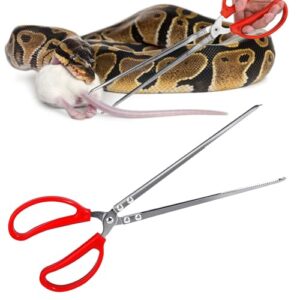
Extra-long stainless steel feeding tongs—usually 12–15 inches—aren’t just convenient for snake breeding; they’re essential for Feeding Safety and proper Snake Handling. You’ll maintain a safe distance from rapid-strike feeders while mimicking natural foraging behavior, which promotes healthy Reptile Nutrition patterns.
Look for serrated or ribbed tips; they reduce food slippage by roughly 30% during sessions with oily prey. In breeding environments where multiple enclosures demand attention, Tong Maintenance matters—sanitize with chlorhexidine solution between uses to prevent cross-contamination.
Models constructed from 304-grade steel resist corrosion in humid Reptile Care settings, extending functional lifespan to 5–8 years with proper cleaning.
Best For: Snake breeders and reptile hobbyists who handle rapid-strike feeders like ball pythons or rat snakes and need a safe distance tool that improves feeding accuracy while maintaining biosecurity across multiple enclosures.
- 12–15 inch length keeps your hand safely away from aggressive feeders while serrated tips cut food slippage by roughly 30%, giving you reliable control during fast-strike feeding sessions.
- 304-grade stainless steel resists corrosion in humid terrariums and lasts 5–8 years with basic cleaning—just wash after each use and disinfect monthly with diluted chlorhexidine.
- Works beyond snake feeding for aquarium debris removal and handling insects or small rodents, making it versatile across different reptile species and terrarium maintenance tasks.
- Deep ridges can trap food debris or substrate particles, requiring more thorough cleaning between uses to prevent bacterial buildup in multi-enclosure setups.
- Some models bend under pressure when handling prey over 50 grams, so you’ll need to grip carefully to avoid warping the steel or accidentally releasing food mid-feeding.
- The 15-inch length, while safe, can feel awkward in smaller enclosures or when precision-placing food for juveniles, making shorter tongs easier for compact terrariums.
2. Bearded Dragon Treat Food Mix
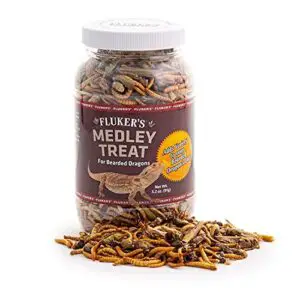
Vitamin-enriched insect blends designed for bearded dragons can serve double-duty in snake breeding programs when dietary needs call for varied reptile nutrition. Fluker’s Dragon Medley—freeze-dried mealworms, grasshoppers, and crickets—delivers 40–60% protein with calcium supplements and vitamin D3 integration, supporting egg-laying females or hatchlings shifting to solid prey.
You’ll maintain nutrient balance by soaking pellets in a 2:1 water ratio initially, which improves food safety and palatability. Limit these treats to 10–20% of total intake; that way, husbandry practices align with species-specific vitamins and minerals requirements without overloading juveniles with sugars or disrupting reptile care protocols.
Best For: Bearded dragon owners seeking a convenient, vitamin-enriched freeze-dried insect blend that supplements fresh vegetables while providing essential proteins and minerals for reptiles at any life stage.
- Delivers 40–60% protein from mealworms, grasshoppers, and crickets with added calcium and vitamin D3 to support bone health and metabolic function
- Freeze-dried format preserves nutrition and flavor while eliminating the hassle of storing and handling live insects
- Suitable for all life stages with flexible feeding options—can be served dry or rehydrated with a 2:1 water ratio for improved palatability
- Some bearded dragons may reject the dry texture compared to live prey, requiring a gradual transition period or moisture supplementation
- Insect flaking creates powder residue at the container bottom, which can be wasteful and messy during feeding
- Should not exceed 10–20% of total dietary intake, meaning it can’t fully replace live insects or fresh vegetables in a balanced feeding program
3. Digital Indoor Thermometer Humidity Monitor
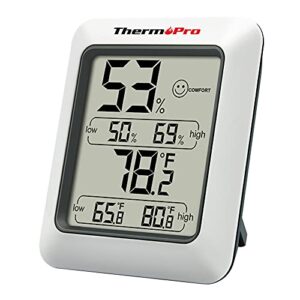
ThermoPro’s compact hygrometer—sporting ±2–3% RH accuracy and 10-second refresh cycles—anchors environmental tracking when temperature gradients and humidity levels shift during breeding season. You’ll position the 2.62″ display near substrate or mid-enclosure zones to capture real-time ambient readings between 25–31 °C and 60–70% RH, essential for egg incubation success.
Digital thermometers with high and low records let you verify thermostat calibration without guesswork, while magnetic backing simplifies sensor placement across multiple enclosures.
That precision—paired with humidity control feedback—prevents dehydration, respiratory stress, and failed clutches in species from ball pythons to boas.
Best For: Reptile breeders and hobbyists who need reliable, real-time humidity and temperature tracking in multiple enclosures without breaking the bank.
- Refreshes every 10 seconds with ±2–3% RH accuracy, giving you instant feedback when misting or adjusting heat sources during critical incubation periods.
- Magnetic back and tabletop stand let you reposition the compact 2.62″ unit quickly across different zones—humid hides, basking spots, or egg boxes—without tools or adhesive.
- Records high and low readings so you can catch overnight temperature drops or humidity spikes that stress reptiles or compromise clutch viability.
- Display can be hard to read in dim lighting or across larger rooms, forcing you to move closer during nighttime checks.
- Some users report accuracy drift over time, requiring periodic cross-checks with calibrated probes to maintain breeding-grade precision.
- Single AAA battery means you’ll need to track replacement schedules across multiple units to avoid gaps in environmental data.
4. Combat Medical Iv Access Bands
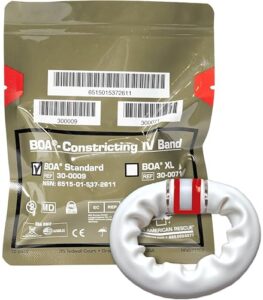
When handling hatchlings or injured snake species during reptile breeding, you’ll need quick venous access if emergency medical care becomes critical—that’s where NAR’s BOA constricting band enters your tactical care toolkit. This patented rolling-action tourniquet, originally designed for Combat Medicine and IV Access Tools, uses venous constriction to distend veins during shock or dehydration, improving first-attempt catheter placement.
Though technically Medical Bandages for human field trauma, the Quick Click connector and rugged vacuum-sealed packaging make it invaluable when transporting distressed adults or managing post-incubation complications that demand rapid veterinary intervention.
Best For: Combat medics, first responders, emergency medical professionals, and tactical medical teams who need fast, reliable IV access in high-stress field conditions or with difficult-access patients.
- Revolutionary rolling action improves vein distension and increases first-attempt IV success rates, especially in challenging patients with poor venous access
- Quick Click connector and two-finger Quick Release system allow for fast, one-handed application without tying knots—critical in emergency situations
- Rugged vacuum-sealed packaging ensures sterility and field-ready deployment for both military combat and civilian prehospital care
- Can cause skin pinching or discomfort if not applied carefully, and may be too tight for some patients
- Single-use design limits cost-effectiveness, though some users report reusing them despite manufacturer guidance
- Standard size may not fit larger patients adequately, requiring the XL version for proper venous constriction
Frequently Asked Questions (FAQs)
What permits are required for breeding snakes?
Breeding snakes requires different permits depending on your location and species. Federal permits apply when importing wildlife under the Lacey Act and CITES, with fees and processing times varying widely.
State licenses for captive breeders range from $25 to $150, with some requiring breeding certificates, vendor applications, or liability insurance for venomous species and large constrictors.
How do you market and sell bred snakes?
You can market bred snakes through online marketplaces like MorphMarket, reptile expos, and social media platforms. Pricing strategies depend on morph rarity and genetic quality.
Understanding buyer demographics—especially Millennials seeking unique morphs—helps target marketing efforts.
Shipping logistics require specialized packaging and overnight carriers. Always follow ethical guidelines for responsible reptile breeding and transparent sales practices.
What genetic mutations affect breeding outcomes?
Genetic disorders can devastate an entire breeding program overnight. Morphs like the spider gene cause wobble syndrome in roughly 50% of offspring, resulting in tremors and neurological issues. Lethal combinations produce 25% non-viable hatchlings, while inbreeding increases embryonic mortality by 20-40%.
Maintaining genetic diversity prevents hereditary traits from compromising breeding outcomes and hatchling health.
How do you manage breeding records effectively?
You’ll maintain detailed breeding logs that include species identification, individual snake IDs, parentage data, and clutch information.
Digital tools like ReptileBuddy or SnakeKeeper simplify record keeping and genetic tracking, improving breeding success rates by 10-20% through better data analysis.
What insurance covers snake breeding operations?
You’ll need liability coverage to protect against snake bites and injuries, property insurance for your facilities and equipment, and livestock policies covering mortality and disease risks—premiums usually run $150-$500 annually for standard liability protection.
Conclusion
One wrong pairing could cost you an entire season—or worse, produce animals that suffer. This snake species breeding guide isn’t about shortcuts; it’s about mastering the variables that separate failed clutches from thriving offspring.
Temperature miscalculations, incompatible genetics, and rushed introductions account for most breeding disasters, yet each is preventable with disciplined protocol.
Your success depends on treating reproduction as the controlled process it is: calculated pairings, monitored incubation, and careful hatchling management. Precision here doesn’t just improve results—it defines them entirely.
- https://www.merckvetmanual.com/multimedia/table/important-husbandry-requirements-for-selected-reptiles
- https://reptilesupershow.com/mastering-snake-breeding-tips-for-healthy-serpents/
- https://pmc.ncbi.nlm.nih.gov/articles/PMC8203107/
- https://www.usgs.gov/publications/parentage-and-sibship-relationships-among-captive-snakes-phoenix-zoo-2024-data-summary
- https://southernafricanherpetologists.com/blog/f/snake-conservation---captive-breeding-rescue-with-release

